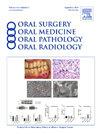Ultrasound protocols for measuring masseter muscle
IF 2
3区 医学
Q2 DENTISTRY, ORAL SURGERY & MEDICINE
Oral Surgery Oral Medicine Oral Pathology Oral Radiology
Pub Date : 2025-02-04
DOI:10.1016/j.oooo.2024.11.008
引用次数: 0
Abstract
Objective
Temporomandibular disorders are frequently treated using botulinum neurotoxin, which may relieve pain by limiting masseter muscle function and reducing size. Masseter size is generally measured by direct visualization/palpation. Muscle size can be objectively and noninvasively imaged using 2-dimensional (2-D) ultrasound, but protocols have not been standardized. This study aims to validate 2-D ultrasound protocols for measuring masseter muscle.
Study Design
Ten adult volunteers were recruited. Each volunteer was scanned (right/left masseters) in relaxed/clenched positions. A single muscle examination consisted of a 2-,D a 3-dimensional (3-D), and then a second 2-D scan. SCAN 2-D scanning protocol included 3 short-axis (superior/middle/inferior) and 3 long-axis (anterior/middle/posterior) views. Each subject was scanned twice, roughly 15 minutes apart. The 3-D scanning protocol consisted of 30-second sweeps acquired over the muscle. Shallow/deep muscle borders were manually traced on all images. Average muscle thickness and thickness at the image center were calculated using custom software. Agreement between scans was assessed using the Bland-Altman plot. We compared 2-D scan measurements with the 3-D reconstructed measurements.
Results
(1) High intra-rater (intraclass correlation coefficient = 0.99) and inter-rater (intraclass correlation coefficient = 0.98) reliability was found. (2) Muscle thickness measured at the image center is similar to the average muscle thickness. (3) Most repeatable scan location is at the longitudinal middle in both relaxed/clenched states. (4) Scanning muscle at both states are repeatable, with relaxed scans yielding slightly greater repeatability. (5) Difference in repeatability when the operator stood at the same and opposite side of the muscle scanned is negligible. (6) Location of the maximum thickness increase in the clenched state varied between subjects. (7) Measurements from 2-D scans are correlated to 3-D volume measurements, R-squared = 0.86 (clenched), 0.95 (relaxed).
Conclusions
Our 2-D scanning protocol is reproducible regardless of muscle contraction state or the operator position. The result of this study is that our protocol allows better observation of muscle size/thickness changes, which can lead to better treatment analysis after neurotoxin or trigger point injection in the clinic.
求助全文
约1分钟内获得全文
求助全文
来源期刊

Oral Surgery Oral Medicine Oral Pathology Oral Radiology
DENTISTRY, ORAL SURGERY & MEDICINE-
CiteScore
3.80
自引率
6.90%
发文量
1217
审稿时长
2-4 weeks
期刊介绍:
Oral Surgery, Oral Medicine, Oral Pathology and Oral Radiology is required reading for anyone in the fields of oral surgery, oral medicine, oral pathology, oral radiology or advanced general practice dentistry. It is the only major dental journal that provides a practical and complete overview of the medical and surgical techniques of dental practice in four areas. Topics covered include such current issues as dental implants, treatment of HIV-infected patients, and evaluation and treatment of TMJ disorders. The official publication for nine societies, the Journal is recommended for initial purchase in the Brandon Hill study, Selected List of Books and Journals for the Small Medical Library.
 求助内容:
求助内容: 应助结果提醒方式:
应助结果提醒方式:


